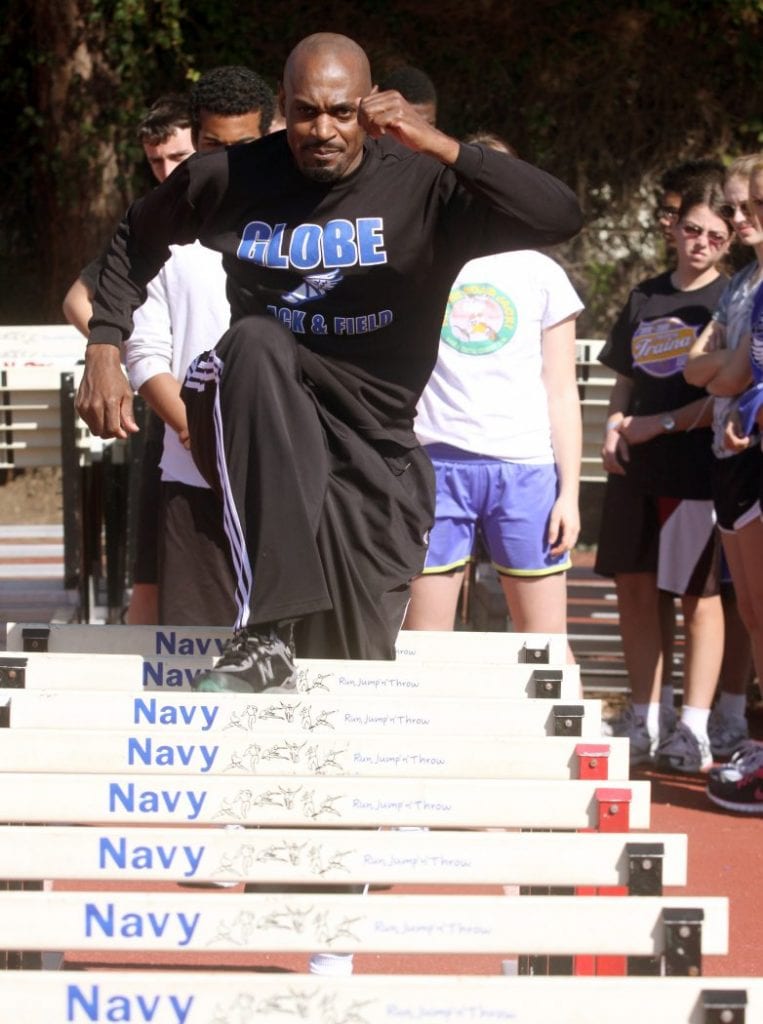Several Former Track & Field Olympians Unite For James Logan Track Clinic And A Week Of School Visits •
In choosing a theme and honorees for his upcoming Olympians Week, Lee Webb looked toward one specific year. One tumultuous yet momentous year.
1968.
The 32nd anniversary of the Willie Davenport Olympian Track and Field Clinic on Feb. 9 will be the culmination of a week full of events featuring numerous Bay Area school visits by some of the greatest U.S. Olympians. All of it organized once again by Webb, the longtime track and field coach and teacher at James Logan High in Union City.
The clinic at James Logan will be dedicated to the 1968 Olympic Team, Speed City — the legendary San Jose State program intertwined with the track and field success in Mexico City and beyond — and 1968 gold medalist Dick Fosbury, innovator and legend of the high jump..
More than a dozen athletes from the ’68 Games will take part in Webb’s clinic. They will work with youth and adult athletes as well as Special Olympians, whose involvement Webb has always made a focal point of the event.
One of the best track and field performances by the U.S. came at those Olympics. In all, the U.S. racked up 45 gold medals. That included 15 in track and field events (12 in men’s events). Names like Fosbury, Jim Hines, Willie Davenport, Tommie Smith, John Carlos, Bob Beamon, Al Oerter and Wyomia Tyus built their legends at these Games.
Olympians Return
Several of those Olympians — representing multiple eras — have been regular attendees of Webb’s event. And they will be back this year.
“When we come, we come for Lee Webb. We are there to support Lee Webb,” said Dr. Melvin Pender, among the 1968 gold medalists attending. Pender, who won gold as part of the 4×100 relay and earned a Bronze Star in Vietnam, is a frequent participant in the Olympians Week.
“God has blessed me; I have done two tours of Vietnam, and I am now 81 years old, but it doesn’t stop me from helping people and loving my country,” Pender said.
He hopes to inspire young students when he and other Olympians visit schools in Union City, Fremont, Newark and San Leandro, among others during the Olympians Week.
“We hope some of those kids will think, ‘These guys are my heroes,’” Pender said, adding they hope to inspire the young athletes to reach college and achieve their dreams.
Special Relationships
Webb describes having friendships with such renowned Olympians as “pretty incredible.”
“I feel really fortunate to be able to do this, and it is because they come,” Webb said. “They competed because they love to do it, and they do this not for money. These are genuine, nice people.”
One of those was Davenport, who won the gold in the 110-meter hurdles in 1968 and the bronze in 1976. He died in 2002 of a heart attack but his inspiration burns brightly. Webb said that Davenport was a driving force in this event becoming what is today.
“When we started getting it going, he always asked to come, and then he would tell others to come,” Webb said. “It was like he was the captain of the team and he was getting his teammates to go, too.
“He exemplified everything we were looking for … he served this country in the military, he worked with Special Olympics. It was a pretty easy one when it came to naming it after him.”
Those Summer Games in Mexico City were the first to be fully broadcast in color and Americans made the most of that spotlight.
Al Oerter won his fourth gold in the discus. Fosbury revolutionized the high jump by pioneering the back-first technique — dubbed the Fosbury Flop — that became the standard approach. Bob Beamon set the world record in the long jump. Hines did the same in the 100 meters, breaking 10 seconds for the first time. Tyus became the first to repeat as gold medalist in the 100.
Tumultuous Year
It all came in a year that was one of the most tumultuous in U.S. History. Civil rights leader Dr. Martin Luther King Jr. and presidential candidate Senator Robert F. Kennedy each were assassinated. The Vietnam War raged on, as protests of the war heated up. The country was in turmoil.
Social activism was on the rise, leading to one indelible image during the Mexico City Games.
After Tommie Smith won gold and John Carlos the bronze in the 200 meters, each raised a black-gloved fist in protest on the medal podium during the U.S. national anthem. To say their Black Power salute was widely controversial would be a vast understatement. But as time went on, the two have received numerous honors for their activism.
Both Smith and Carlos will be in attendance, along with fellow Speed City teammate and ‘68 Olympian Lee Evans.
Fosbury, Hines, Tyus Beamon, and other 1968 competitors like Reynaldo Brown, Larry Livers, Ed Caruthers, Leon Coleman, Madeline Manning Mims and Ron Freeman also will attend. Coming are more recent Olympians like Eddie Hart, Dwight Phillips, Tim Bright, Andre Phillips, James Robinson, Dawn Ellerbe, Harvey Glance and many more.
Fame didn’t come easily for the 1968 Olympians, but it has endured.
“These Olympians didn’t rack up the commercial endorsements like Michael Phelps and others have,” Webb said. “But Mel Pender, Eddie Hart, John Carlos, Tommie Smith and many others have written books.”
Another chapter is being written this February. ϑ
UPDATE: See our coverage of the event [HERE]
[bsa_pro_ad_space id=2]

